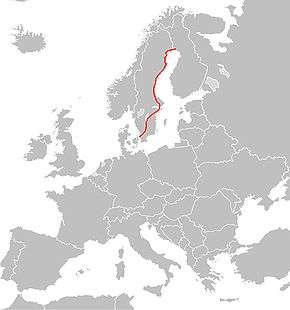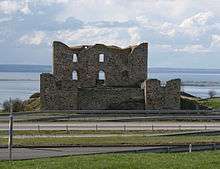European route E4
| |
|---|---|
 | |
| Route information | |
| Length: | 1,590 km (990 mi) |
| Major junctions | |
| South end: | Helsingborg (Sweden) |
| North end: | Tornio (Finland) |
| Location | |
| Countries: |
|
| Highway system | |
| International E-road network | |



| Wikimedia Commons has media related to European route E 4. |
European route E 4 passes from north to south through Sweden from the border with Finland, with a total length of 1,590 kilometres (990 mi). The Finnish part lies entirely within Tornio in northern Finland, and is actually only 800 metres (0.50 mi) long. The Swedish part, however, traverses most of Sweden except the extreme north and the west coast region, and is commonly considered the highway backbone of Sweden, since it passes in the vicinity of most of its largest cities (exceptions include Gothenburg, Karlstad, Västerås, Östersund and Örebro) and through the capital Stockholm. In particular, it is the mainline road used by most vehicle traffic, both personal cars and freight trailers, between the north (Norrland) and southern Sweden or beyond.
From Haparanda on the Finnish border, it stretches south along the Gulf of Bothnia to Gävle, then on a more inland route southwards. It ends in Helsingborg in Sweden, at the port for the ferry to Elsinore in Denmark. Under the new system of European routes, it was planned to have been a part of E 55, but it remains in the pre-1992 designation (E 4) within Sweden, because the expenses connected with re-signing this long road portion would be too large. Besides the signs along the road, there are thousands of signs, especially in cities, showing how to reach the E 4 road. The road is now fully authorized as E 4 by the relevant authority, not as E 55.
North of Gävle the road is of mixed standard. Depending on the fashion at the time of construction it is either a single standard carriageway road, usually 8–13 metres (26–43 ft) wide, or a 2+1 road, a 13–14 metres (43–46 ft) wide road with two lanes in one direction and one in the other with a steel wire barrier in between, or sometimes a motorway with two lanes in each direction. From Sundsvall and further north, the road passes through most larger cities as city streets.
South of Gävle, the road becomes an almost continuous motorway. On October 17, 2007, the final stretch of the motorway, between Uppsala and Mehedeby was opened. South of Gävle, the speed limit is 110 km/h (68 mph) on 60% and 120 km/h (75 mph) on 30% of the road. North of Gävle there are varying speed limits, with 90 km/h (56 mph), 100 km/h (62 mph) and 110 km/h (68 mph) as the most common. The speed limits on the main roads in Sweden were changed on many stretches in October 2008, which saw the introduction of the 120 km/h limit.[1]
The E 4 is the fastest road to go from Germany/Denmark to areas north of the arctic circle, including places in Norway like Tromsø. To go from Helsingborg to the North Cape, the fastest road is E 4 to Luleå, then E 10, road 392, road 403, E 08 and road 93 to Alta and on.
The route passes through or nearby the cities Tornio, Haparanda, Luleå, Piteå, Skellefteå, Umeå, Örnsköldsvik, Härnösand, Sundsvall, Hudiksvall, Söderhamn, Gävle, Uppsala, Stockholm, Södertälje, Nyköping, Norrköping, Linköping, Jönköping, Värnamo, Ljungby, Helsingborg.[2]

